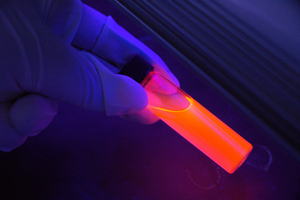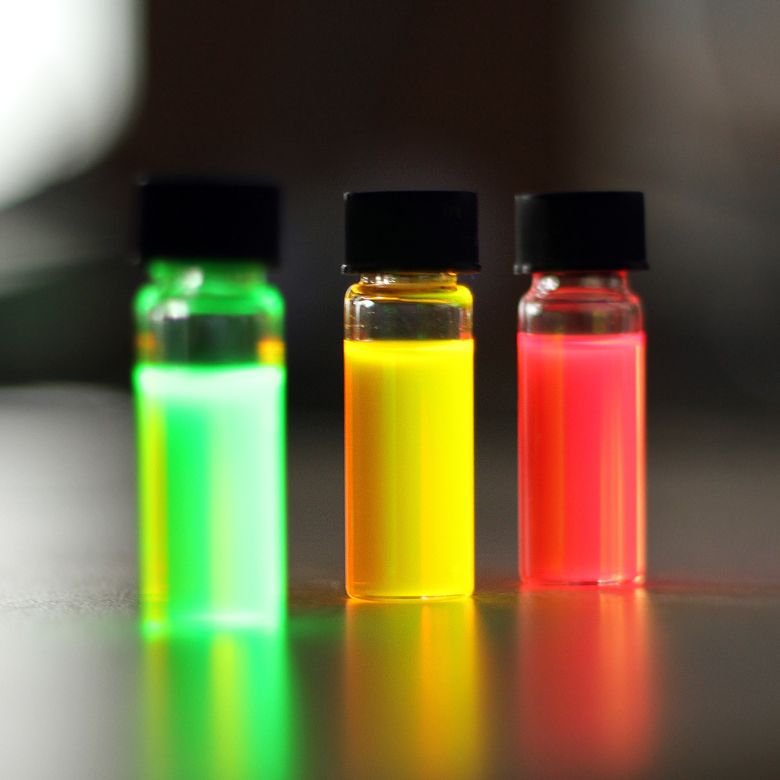By definition, luminescence is the emission of light by cold objects, as opposed to incandescence, which is the emission of light by hot objects. Simply put, it is radiation of non-thermal origin. In molecular terms, it is a phenomenon resulting from the transition of molecules from an excited state to the basic state. As a result of this transition, radiation is emitted.

Any energy absorbed by the system must be emitted. It occurs in several ways, e.g. in the form of luminescence, heat or conformational changes in molecules. According to the scientist Sergei Vavilov: “Luminescence is the excess of a body’s radiation over the temperature radiation of the same body in a given spectral region and at a given temperature, which is also characterized by a finite illumination time, i.e. it does not disappear immediately after the excitation is interrupted.”
Types of luminescence
We distinguish different types of luminescence according to the factor that excites them to illuminate. The most popular are:
- Photoluminescence, where the excitation factor is electromagnetic radiation from the visible, ultraviolet or infrared spectrum. The emitted energy, in the form of light, is usually less than the excitation energy.
- Chemiluminescence, where a substance is excited by chemical reactions, this phenomenon occurs for example due to the oxidation of luminol. It is used for the detection of blood at a crime scene – a mixture of luminol and hydrogen peroxide – a strong oxidant – is sprayed.
- Bioluminescence, characterized by the excitation of substances as a result of biochemical reactions, can be observed in fireflies. In practice, this type of radiation emission is caused by an enzymatic reaction that leads to the oxidation of luciferin by luciferase. All living organisms have the potential of bioluminescence, but it is usually too low to be noticed.
- Electroluminescence, where the excitation of a solid takes place in an alternating or constant electric field, whereasgases undergo electroluminescence under electric discharges. This phenomenon is used, among others, in fluorescent lamps, electroluminescent capacitors and image converters.
- X-ray luminescence is the emission of light caused by X-rays. Enhancing screens used to improve image quality are based on this phenomenon, using calcium tungstate.
In addition, there are many other types of luminescence, such as radioluminescence, electron-stimulated luminescence, sonoluminescence, triboluminescence and thermoluminescence.
Photoluminescence
Photoluminescence is the most frequently used phenomenon in chemical analysis. It can be categorized into two main categories according to the mechanisms of electronic transitions, or more vividly according to the time between the absorption and emission of energy. These are:
- Fluorescence, which is a short-term illumination, where no more than 10-8 seconds pass from energy absorption to emission. It occurs in the case of a spontaneous transition from a higher energy level of an electron to a lower one.
- Phosphorescence is a phenomenon of long-term illumination, which occurs in a time longer than 10-8 s from the absorption of energy. Sometimes it even takes hours or days to emit light. This type of energy requires the existence of metastable levels and is created with the participation of the thermal energy of the medium.
The energy of fluorescence and phosphorescence is much lower than the energy of the excitation radiation. It results from the energy degradation of the molecule through non-radiative, thermal transitions. Since the emitted photons have a lower energy than the excitation ones, the emission spectrum shifts towards longer wavelengths. The phosphorescence spectrum is the most shifted, because the transition of the molecular state occurs not from the level of the zero excited singlet state S1 as in the case of fluorescence, but from the level of the zero triplet state T1 to any oscillatory-rotation level of the singlet ground state S0. Such transitions can be graphically observed in the Jablonski diagram.

Fluorescence
Fluorescence is the most frequently used phenomenon of luminescence in chemical analysis. Such radiation emission is described by several basic features, i.e.: the absorption spectrum, fluorescence spectrum, absolute fluorescence quantum efficiency and duration of emission. The absolute quantum yield is the ratio of the number of quanta of the emitted radiation to the number of quanta of the excitation radiation. The duration of the emission is the time in which the fluorescence intensity decays to a certain value. Concentration quenching is also an interesting phenomenon. It is characterized by the concentration limit of the phosphor in the solution, beyond which the fluorescence begins to decrease. A phosphor is a chemical compound that exhibits luminescence. These are, e.g. polymers, eosin, ZnS sulphides and yttrium oxysulphides.
Photoluminescence of organic compounds
It turns out that there are many regularities that organic molecules show in relation to photoluminescence. Their fluorescence band is shifted in relation to the absorption band towards longer wavelengths, but the spectra partly overlap. There is also a proportional relationship between the excitation light intensity, absorption and quantum yield of fluorescence and fluorescence. Therefore, it is possible to use it in qualitative and quantitative analysis. Quantitative analysis using this phenomenon is called spectrofluorimetry. The technique has a lower limit of detection compared to absorption spectrophotometry and is highly selective. Selectivity results from the fact that specific chemical compounds, derivatives of aryl compounds, having a conjugated system of double bonds, undergo fluorescence. In practice, this means that the more aromatic rings in the structure, the stronger the fluorescent properties of the chemical. The application of spectrofluorimetry in organic chemistry includes the analysis of biologically active compounds, such as vitamins, amino acids, proteins; pharmaceuticals, including antibiotics; food compounds such as carbohydrates and fats and environmental toxicants such as PAHs (polycyclic aromatic hydrocarbons).
Spectrofluorimetry of inorganic compounds
Inorganic chemistry assays based on the phenomenon of fluorimetry are performed using the mechanism of the formation of chelate complexes between elements such as aluminium, beryllium, magnesium, calcium and rare earth elements with appropriate organic ligands. These complexes exhibit a specific fluorescence and the limits of detection are very low.
| Reagent | Assayed element | Sensitivity [μg·cm-1] |
| Salicyl-o-aminophenol | Al
Ga Sb |
0.0005
0.15 0.2 |
| IREA lumonomagnesone | Mg | 0.002 |
| Morin | Fe
Th |
0.001
0.0004 |
Table 1. Examples of reagents used for the fluorimetric determination of metals and LoD.